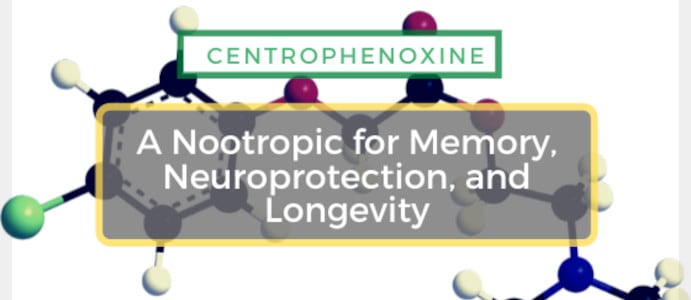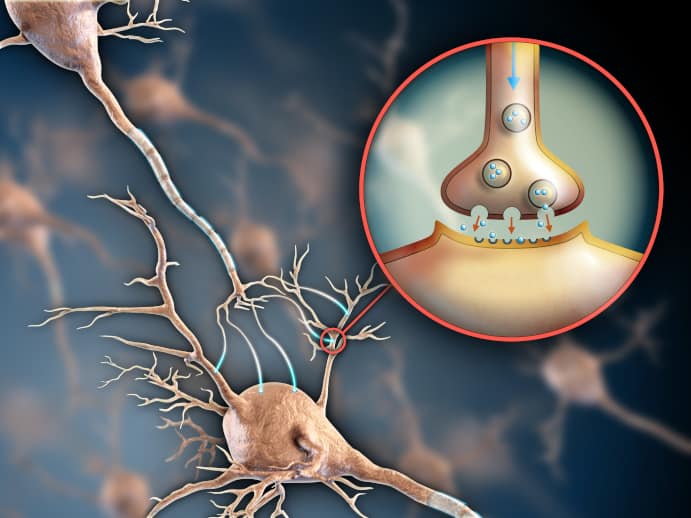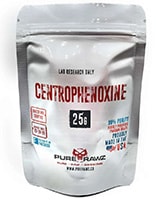

Centrophenoxine, also known as Meclofenoxate and Lucidril, is one of the most well-studied cholinergic nootropics to date. It has been used safely for over fifty years to increase mental function and general cognition in both diseased and healthy users. Decades of research support its cognitive-enhancing effects, namely, its ability to boost memory, confer neuroprotection, and increase longevity.
>> Looking to Buy Centrophenoxine? Click here to see our recommended sellers.
What is Centrophenoxine?
In 1959, the French National Scientific Research Center developed centrophenoxine. It was initially used as a treatment for dementia associated with neurodegenerative disorders, insufficient blood flow to the brain, and age-related cognitive decline. Over the decades, it has been used therapeutically for brain injury, cerebral atrophy, post-stroke recovery, chronic alcoholism, and barbiturate intoxication.[1]Roy, D., Pathak, D. N., & Singh, R. (1983). Effect of centrophenoxine on the antioxidative enzymes in various regions of the aging rat brain. Experimental Gerontology, 18(3), 185–197. As a nootropic in healthy individuals, centrophenoxine shows cognitive-enhancing properties alone and especially stacked with other cognitive enhancers such as the racetams.
Centrophenoxine is a combination of two compounds:
- Dimethyl-aminoethanol (DMAE): DMAE is a natural compound found naturally in small amounts in the brain and seafood. It is a precursor to choline, which supports the synthesis of the endogenous neurotransmitter acetylcholine.
- parachlorophenoxyacetate acid (pCPA). pCPA is a synthetic auxin. Auxins are plant growth hormones. The addition of pCPA helps DMAE’s bioavailability, allowing it to cross the blood-brain barrier effectively.
Centrophenoxine can be easily obtained online or over the counter as a dietary supplement. It is usually consumed in tablet, capsule, or powder form. In some countries, such as Japan, Germany, Hungary, and Austria, it is available as a prescription drug.
Confirmed Mechanisms of Action
- Boosts acetylcholine levels.[2]Georgiev V, Chavdarov D, Petkov V, Kirilov B. Effect of centrophenoxine on acetylcholine release in perfused cerebral ventricles of cats under dynamic electrophysiological control. Acta Physiol Pharmacol Bulg. 1979;5(3):59-66. Acetylcholine is a vital neurotransmitter that is involved in memory formation, attention, and learning. DMAE is approximately half as potent as centrophenoxine at increasing acetylcholine levels.[3]Wood PL, Péloquin A. Increases in choline levels in rat brain elicited by meclofenoxate. Neuropharmacology. 1982;21(4):349-354.
- Reduces the formation of lipofuscin.[4]Georgiev V, Chavdarov D, Petkov V, Kirilov B. Effect of centrophenoxine on acetylcholine release in perfused cerebral ventricles of cats under dynamic electrophysiological control. Acta Physiol Pharmacol Bulg. 1979;5(3):59-66. Lipofuscins are waste products, composed mostly of lipids, that build up in the brain as we age. Lipofuscins have been implicated in the pathogenesis of neurodegenerative disorders such as Parkinson’s disease and Alzheimer’s disease.[5]Giaccone G, Orsi L, Cupidi C, Tagliavini F. Lipofuscin hypothesis of Alzheimer’s disease. Dement Geriatr Cogn Dis Extra. 2011;1(1):292-296.
- Increases antioxidant enzymes.[6]Roy, D., Pathak, D. N., & Singh, R. (1983). Effect of centrophenoxine on the antioxidative enzymes in various regions of the aging rat brain. Experimental Gerontology, 18(3), 185–197. By scavenging free radicals, centrophenoxine protects neurons from toxic oxidative stress.
- Enhances RNA synthesis in the brain.[7]Zs.-Nagy, I., & Semsei, I. (1984). Centrophenoxine increases the rates of total and mRNA synthesis in the brain cortex of old rats: An explanation of its action in terms of the membrane hypothesis of aging. Experimental Gerontology, 19(3), 171–178. In turn, this mechanism increases the rate of protein turnover, thereby reducing age-dependent neuronal damage.
- Stimulates brain-wide metabolism.[8]Ludwig-Festl M, Gräter B, Bayreuther K. Increase in cell metabolism in normal, diploid human glial cells in stationary cell cultures induced by meclofenoxate. Arzneimittelforschung. 1983;33(4):495-501. Centrophenoxine increases the availability of oxygen and glucose in neurons and glia in vitro and in vivo.
The Effects of Centrophenoxine
Centrophenoxine Boosts Memory and Learning Capacity

Centrophenoxine’s positive effects on memory and learning have been borne out in animal trials and several human trials with elderly and dementia patients.
A 1978 study investigated the effects of centrophenoxine on learning and memory in aged female mice. The researchers administered 80mg/kg of centrophenoxine daily for three months and subsequently tested memory and learning with a T-maze. Compared to untreated mice, the centrophenoxine-treated group completed the memory task in significantly fewer trials. These positive results were correlated with reductions in neuronal lipofuscin pigments in both the cerebral cortex and hippocampus.[9]Nandy, K. (1978). Centrophenoxine: Effects on Aging Mammalian Brain. Journal of the American Geriatrics Society, 26(2), 74–81.
Human trials in elderly and demented patients corroborate the positive effects of centrophenoxine on memory performance. In one 1977 study, 76 healthy elderly participants were divided into two groups and took a placebo or 600mg of centrophenoxine twice daily. The centrophenoxine-treated group demonstrated better memory performance on a free-recall test, suggesting it facilitates the ability to transfer new information into long-term memory. Also, in a post-trial questionnaire, significantly more of the subjects taking centrophenoxine reported increased levels of alertness and well being.[10]Marcer D, Hopkins SM. The differential effects of meclofenoxate on memory loss in the elderly. Age Ageing. 1977;6(2):123-131.
Another double-blind clinical trial from 1989 investigated the effects of centrophenoxine on memory in 50 participants with moderate dementia. The researchers gave the group a placebo or 2 grams of centrophenoxine for eight weeks. The centrophenoxine-treated group showed a 48% improvement in memory functions, compared to just 28% in the placebo group. In addition to improving cognition testing after eight weeks, centrophenoxine also significantly increased intracellular water content in the treated group. These findings support its ability to act as a powerful antioxidant.[11]Fülöp T Jr, et al. Effects of centrophenoxine on body composition and some biochemical parameters of demented elderly people as revealed in a double-blind clinical trial. Arch Gerontol Geriatr. (1990).
Centrophenoxine May Confer Neuroprotection

Centrophenoxine may protect neurons from stress and damage by acting as an antioxidant and reducing neuronal damage caused by free radicals.
Specifically, centrophenoxine may exert neuroprotective effects by reducing free radical damage induced by aging, heavy metals, stroke, and neurodegenerative diseases.[12]Liao Y, Wang R, Tang XC. Centrophenoxine improves chronic cerebral ischemia induced cognitive deficit and neuronal degeneration in rats. Acta Pharmacol Sin. 2004;25(12):1590-1596.[13]Nehru B, Verma R, Khanna P, Sharma SK. Behavioral alterations in rotenone model of Parkinson’s disease: attenuation by co-treatment of centrophenoxine. Brain Res. 2008;1201:122-127.[14]Nehru B, Bhalla P, Garg A. Evidence for centrophenoxine as a protective drug in aluminium induced behavioral and biochemical alteration in rat brain. Mol Cell Biochem. 2006;290(1-2):33-42.
Rodent studies have found that centrophenoxine treatment increases the activity of antioxidant enzymes such as catalase, glutathione reductase, and superoxide dismutase.[15]Bhalla P, Nehru B. Modulatory effects of centrophenoxine on different regions of ageing rat brain. Exp Gerontol. 2005;40(10):801-806. By increasing the activity of free radical-scavenging enzymes, centrophenoxine may ameliorate cognitive deficits associated with increased oxidative stress, including impairments to memory, movement, and general cognition.
Also, rodent studies with aged rats have shown centrophenoxine acts as a potent antioxidant against lipid peroxidation. Lipid peroxidation refers to oxidative damage to lipids, a fundamental component of cell membranes. When left unchecked, lipid peroxidation plays an important role in initiating and/or perpetuating the aging process.[16]Sharma, D., Maurya, A. K., & Singh, R. (1993). Age-related decline in multiple unit action potentials of ca3 region of rat hippocampus: Correlation with lipid peroxidation and lipofuscin concentration and the effect of centrophenoxine. Neurobiology of Aging, 14(4), 319–330.
Centrophenoxine may also confer neuroprotection by stimulating brain metabolism. Studies have shown centrophenoxine treatment can promote energy metabolism in the brain by stimulating glucose uptake and oxygen consumption in neurons and glia (the brain’s support cells). Being fundamental processes for energy generation, enhancing neuronal metabolism can support healthy neuronal functioning.[17]Ludwig-Festl M, Gräter B, Bayreuther K. Increase in cell metabolism in normal, diploid human glial cells in stationary cell cultures induced by meclofenoxate. Arzneimittelforschung. 1983;33(4):495-501.[18]Schmid P, Schlick W. Influence of centrophenoxine administered for one year in high dose on maximal oxygen consumption in aged persons. Aktuelle Gerontol. 1979;9(3):125-131.
Centrophenoxine May Increase Longevity

Centrophenoxine may increase longevity by reversing physiological markers of aging in the brain, which includes the buildup of neurotoxic free radicals and lipofuscin. It’s important to note that centrophenoxine’s effects on longevity have been assessed solely in animal models. While the results are encouraging, they offer limited translational insight into the human situation.
According to several rodent studies, centrophenoxine may help age-related decline by reducing the accumulation of lipofuscin in brain tissue. These pigment granules form through fatty acid oxidation and aggregate in neurons. The accumulation of lipofuscin appears to increase with age and contribute to neurodegenerative disorders such as Parkinson’s disease and Alzheimer’s disease.[19]Riga, S., & Riga, D. (1974). Effects of centrophenoxine on the lipofuscin pigments in the nervous system of old rats. Brain Research, 72(2), 265–275.
By scavenging free radicals, centrophenoxine has been shown in rodent studies to increase the rate of mRNA synthesis in the brain cortex of old rats. In one study, centrophenoxine treatment in old rats restored the rate of RNA synthesis to levels found in rats that were half as old. By enhancing RNA synthesis, centrophenoxine can, in turn, increase protein turnover in neurons. Increased protein turnover can improve cell membrane integrity and reduce age-dependent damage to neurons.[20]Zs.-Nagy, I., & Semsei, I. (1984). Centrophenoxine increases the rates of total and mRNA synthesis in the brain cortex of old rats: An explanation of its action in terms of the membrane hypothesis of aging. Experimental Gerontology, 19(3), 171–178.
Overall, centrophenoxine shows lifespan-increasing effects by acting as a potent antioxidant and reducing the toxic buildup of lipofuscin in the brain. Due to the differences in the mechanisms of aging between humans and rodents, these preclinical studies would need additional verification in human trials to confirm the beneficial effects.
Centrophenoxine Dosing

Centrophenoxine is available either as a powder or in capsules that usually contain 200-500mg each.
Clinical trials have used dosages ranging from 600 to 2000 mg/day. In studies with healthy elderly participants, daily dosages of 1,200mg have been used safely. Studies with dementia patients have used daily dosages up to 2,000mg.
If centrophenoxine is used for general cognitive enhancement in healthy users, the optimal dose range is 200-300mg up to three times daily. With that said, higher doses may be needed for optimal anti-aging effects.
Centrophenoxine being a fat-soluble compound is best taken with food. Taking it with meals can also reduce the probability of gastrointestinal side effects, such as heartburn.
Centrophenoxine Safety and Cautions
Centrophenoxine is generally well-tolerated and has a track record of long-term safety. The metabolites of centrophenoxine, namely DMAE, phosphatidyl-DMAE, and choline, are naturally found in our bodies and pose no toxic health effects. The pCPA component of centrophenoxine is rapidly secreted in the urine after metabolism.
Centrophenoxine can create potential side effects in some users. These can include, especially in high doses:
- Nausea
- Gastrointestinal issues
- Sleeplessness
- Dizziness
- Muscle tension
- Tremor
- Depression
- Headache
Centrophenoxine should not be taken by individuals with epilepsy, seizures, depression, and bipolar disorders. These disorders can be exacerbated by cholinergic supplements that increase acetylcholine.
Also, centrophenoxine may pose negative interactions with other drugs that affect acetylcholine. This includes acetylcholinesterase inhibitors, cholinergic drugs, and anticholinergic drugs. Be sure to consult a medical professional if you are using any of these drugs before taking centrophenoxine.
Buy Centrophenoxine Online Review Comparison Table
| Product | Company | Quantity | Price | Country | Website |
 Centrophenoxine | PureRawz | 25g | $15.48 |  Worldwide, US, AU | Visit Website >> |
Originally posted on June 27, 2020, last updated on April 1, 2024.
References

Leave a Reply